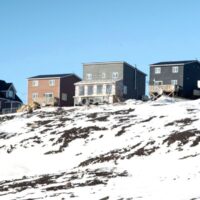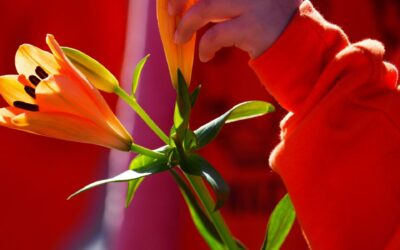Introductions
Elder Connie Crocker
Connie Crocker’s cultural name is Xqulsiim. She is a Coast Salish Elder and her tribe is Pune’luxutth’. Connie is fortunate to have lived her life on the Salish Sea enjoying the lifestyle, culture, and abundant daily resources from the ocean. The four reserve lands of Pune’luxutth’ are located on the east side of Vancouver Island outside of Chemainus and about 80 km from Victoria. Xqulsiim grew up on the North Galiano Island Reserve with awesome parents and five siblings in a unique fishing community. What made it unique was the abundance of salmon, cod, and herring and this drew fishermen from afar to live in their boats for parts of the year. All her brothers and sisters and herself bought boats and chose this way of life for their families. When she was 22 she began buying fish with a truck for Hi-To Fisheries in Cowichan Bay. The next year she bought a 40’ wood packer named the “Advise” so she could better get to the fishing grounds. Life was good until the cod went missing, then two herring seasons were a bust and finally the salmon. The decline of the industry was very evident and 80 per cent of the fleet had to sell. Back to school Connie went and studied information technology and then went to work for Fisheries & Oceans. She now works as a First Nations Liaison with Kelp Rescue Initiative.
Elder Dr. Florence James
Dr. Florence James / Thiyaus is a Coast Salish Elder from the Pune’luxutth’ Tribe. She is a fluent speaker of the Pune’luxutth’ Tribe dialect of the Hul’qumi’num language, which is also part of the Coast Salish Nation. She is an educator and lifelong learner who draws on both her traditional gifts and teachings from her Ancestors and her university-based education. Thiyaus is a highly respected Elder in her community, widely known for her cultural expertise, her knowledge of and dedication to the environment, and her commitment to the care and education of young children. Thiyaus has been a teacher and powerful advocate for many languages, cultural heritage, environmental education, healing, and legal projects for more than 15 years.
Rocky James
Rocky James is from the Pune’luxutth’ Tribe, part of the broader Coast Salish Nation. Rocky carries three ancestral names which are Qwtiis (Qwuh-tees), Siimultun (Sea-muhl-tun), and Thiyaustun (Thii-auhs-tun). Rocky is the Sole Proprietor of Salish Social Policy Design and Practice, which operates with the vision to prepare an increasing number of non-profit, private, and government sectors with the confidence to lead social policy change through Indigenous worldviews, transforming how we design and practice social policy. The mandate is to Increase our motivation to see Indigenous worldviews as a human right across policy sectors by buildingon the following three foundations:
- A strengths-based approach to community-based research for organizational change;
- Training for cultural literacy and cultural competency;
- An Indigenous human development approach to social policy design and practice.
Rocky has a Bachelor of Arts Degree in Indigenous/Hwul’muxw/Hwul’muhw Studies from Vancouver Island University, and a Master of Arts Degree in Studies in Policy and Practice from the Faculty of Human and Social Development from the University of Victoria. Rocky is also enrolled in the Doctor of Social Sciences Program at Royal Roads University, embarking on a personal journey to further his understanding and contribute to the field of Indigenous social science. His title is Standing Two-Spirit People Up in Their Strengths Through Two-Spirit Human Development.

Summary
In July 2024, Maria Shallard, Director Indigenous Research, and Janina Stajic, Communications Manager, met with Florence James, Connie Crocker, and Rocky James, members of Pune’luxutth’ First Nation, as well as Jasmin Schuster, Program Manager at Kelp Rescue Initiative, to learn more about intergenerational perspectives around q’am’ (kelp) and its links to climate change and climate policy. Through our conversation we learned more about the inextricable connection between q’am’ (kelp in Hul’qumi’num) and Pune’luxutth’, and what q’am’ can tell us about the health of the oceans, climate change impacts, and climate policy.
Kelp forests absorb large amounts of carbon and play an important role in reducing emissions. Indigenous approaches to adapt to and mitigate climate change are holistic. From the perspective of kelp restoration this means it is not just about mitigating climate change, but also about protecting marine species, ecosystems, and cultural, physical, spiritual, and mental well-being. Each of these pieces is interlinked and can not be considered or talked about in isolation.
Our conversation concluded with discussions about policy barriers which include current regulations that limit kelp restoration and the lack of education when it comes to the importance of kelp forests and their role in the ocean ecosystem and climatic function. We discussed recommendations (see below) for how provincial climate policy in British Columbia can advance reconciliation and climate mitigation efforts with and alongside coastal Indigenous nations. These included recommendations for how the provincial government can work in partnership with Coastal First Nations to develop robust policies to support kelp restoration on the coast. Further, our conversation suggests that it is imperative to support kelp reforestation by integrating Indigenous knowledge with western science, and by creating programs, incentives, and support for Indigenous youth stewardship and conservation of q’am’ forests.
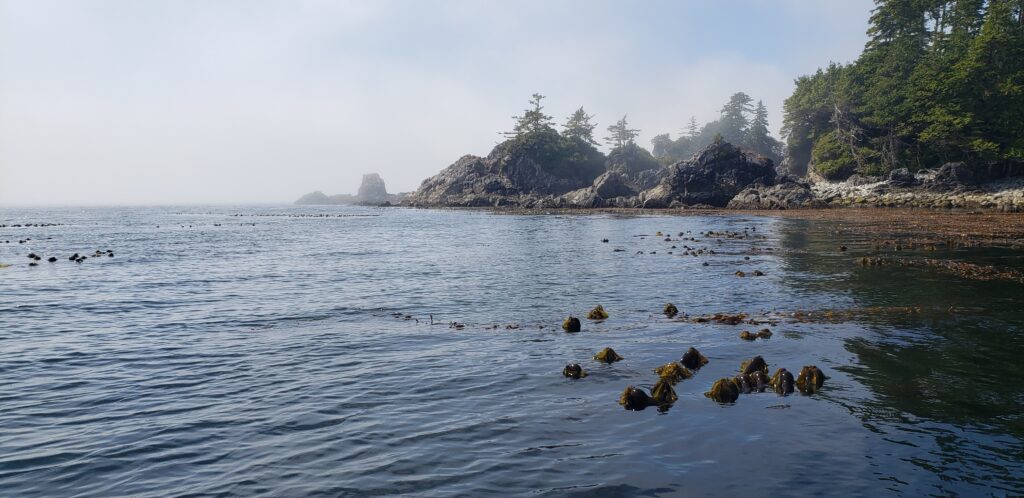
Pune’luxutth’ ways of knowing, q’am’ (kelp), and the connections to climate change and mitigation policy
Connie, can you please tell us about the organization you work with, and your role?
Connie: I work with Kelp Rescue Initiative, a not-for-profit conservation based organization. Kelp Rescue is based out of the Bamfield Marine Sciences Centre and operates under the umbrella of the Western Canadian Universities Marine Sciences Society, a charitable organization whose members include the University of Calgary, University of Alberta, University of British Columbia, Simon Fraser University, and the University of Victoria. The Initiative was created in 2021 when years of research indicated drastic declines of kelp in many coastal areas that needed urgent attention. Since its launch, Kelp Rescue Initiative has led kelp research and restoration projects across British Columbia.
The Initiative’s goal is to bring together a range of scientific expertise and Indigenous knowledge, with a mission to restore q’am’ forests on B.C.’s coast to secure resilient and vibrant ecosystems at an ecologically meaningful scale and to provide accessible restoration resources. My role as a First Nations Liaison is to create awareness and build strong relationships with local communities and First Nations.
In 2023, we were awarded a $3.7 million Aquatic Ecosystems Restoration Fund from Canada’s Department of Fisheries and Oceans, to support kelp restoration over the next four years. Now in the second year of this four-year research project, we are growing kelp in nurseries at Bamfield and Deep Bay. We are testing different kelp culturing and out-planting methods for two species of canopy-forming kelp—giant and bull kelp—found in coastal waters and are testing their success in different conditions and environments.
“I guess the point I want everyone to know though is that the ocean is dying. I want to make sure that people understand the severity of this and the importance of q’am’ forests not only to who we are as Pune’luxutth’ but its role in mitigating climate change and providing opportunities for future generations.”
~ Connie Crocker
Why did the Kelp Rescue Initiative focus on preserving q’am’ forests?
Connie: Q’am’ forests are made up of canopy-forming kelps and are functionally unique ecosystems that grow in cool, temperate coastal waters. They are formed by large brown seaweeds and are among the most abundant and productive coastal ecosystems. These underwater forests provide a 3D physical structure that stretches from the seafloor to the water’s surface and they play a vital and varied role in the ocean ecosystem. Because q’am’ forests have a life cycle that is far quicker than a land forest, they are very effective carbon cyclers and are thus considered to be “blue carbon ecosystems” (ecosystems that capture carbon at a high rate and can store it for quite a long time). Blue carbon ecosystems offer a natural solution to help mitigate some of the impacts of climate change as they capture and store carbon. Our research looks at the holistic role of q’am’ forests within the ocean ecosystem as we know that as well as mitigating climate impacts they also provide food and shelter for hundreds of species, including rockfish, salmon, abalone, and herring; keep coastlines from eroding, and clean ocean water and create oxygen. They also have economic and cultural benefits for Coast First Nations, coastal peoples, and industry.
Yet, these forests have declined or disappeared from many areas around the coastline (and globally), necessitating urgent action to preserve and restore these important ecosystems.
Can you tell us a little bit more about the role kelp plays in mitigating climate impacts ?
Connie and Jasmin: Well, we can but it is difficult to speak about their role in isolation! Essentially, they are ecosystem engineers. They are prolific photosynthesizes, producing oxygen, and cycling and storing both carbon and nutrients. In terms of mitigating climate impacts they both capture carbon and also store it so when q’am’ forests are thriving they work to keep ocean ecosystems in balance, and mitigate the amount of carbon in the atmosphere.
They also form “biogenic habitat”, i.e., the living organism (kelp) that provides habitat for other species, improves water quality, and protects and supports coastal biodiversity and balances ocean acidity. The oceans are becoming more acidic than they have been in at least 20 million years. These changes are making survival and reproduction more difficult for some species.
Why are kelp disappearing so quickly?
Connie and Jasmin: The biggest part is the warming of the oceans, as kelp likes cooler temperatures and currents. So, climate change is now a major threat to q’am’ forests and this valuable ecosystem is rapidly declining around the world from a combination of warming ocean temperatures due to climate change and sea urchin predation. Beginning in 2014 a string of marine heat waves created warmer than normal conditions harming marine ecosystems. And, much like land-based heat waves, marine heat waves are being observed more often, are lasting longer, and are becoming more intense as greenhouse gas emissions continue to rise.
Unfortunately, kelp loss has devastating effects on marine ecosystems. As q’am’ forests decline, so does their ability to support marine ecosystems and mitigate climate impacts.
The heat waves also have unexpected impacts on q’am’ forests. One of these heat waves (2014-16 El Nino + Heat Blob) magnified the ongoing sea star wasting disease—an epidemic that killed millions of sea stars from Mexico to Alaska, including Pycnopodia helianthoides, a prolific urchin predator. This triggered a boom in the sea urchin populations. Over abundant urchins consumed large amounts of kelp creating what is referred to as urchin barrens.
Connie and Florence: Declines in sea otter populations also impact kelp forests. Sea otters, which are a keystone species, were hunted nearly to the brink of extinction by the early 20th century. Lacking predation as a result, sea urchins overpopulated and grazed down q’am’ forests along the coast. When sea otters were reintroduced decades later near Kyuquot, the forests came back. But sea otters are still absent from most of the B.C. coastline today because of the overhunting. This is another example of the human impact on this important ecosystem alongside anthropogenic impacts.
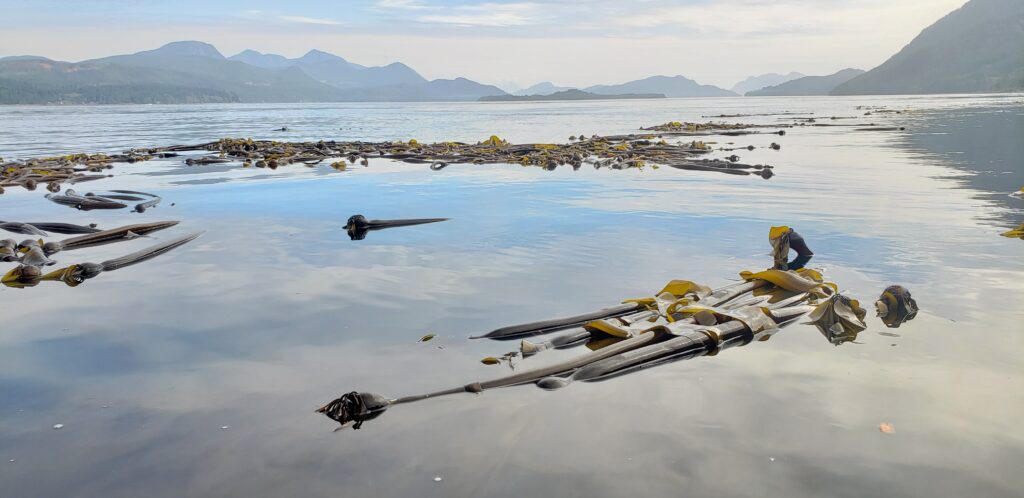
What are some of the benefits of restoring q’am’ forests?
Connie & Florence: Like above-ground forests, q’am’ forests present a possibility to help change the trend of global warming.
They have the potential to sequester significant amounts of carbon to help mitigate some of the impacts from increasing emissions.
This would be a nature-based climate solution. B.C. is prime habitat for kelp abundance and species diversity. If we expand q’am’ forest restoration on a massive scale, they will help with significant removal of greenhouse gasses from the atmosphere while at the same time realizing interlinked and holistic benefits for the ocean, coastal communities, and marine life.
“I can’t imagine an ocean without kelp and all the species that make it home. We need to look at natural environmentally friendly solutions to climate change before we no longer have the option.”
~ Connie Crocker
For example, restoring q’am’ forests at scale also creates jobs, positive livelihood, increases food security, and benefits fisheries.
Q’am’ is a traditional food as is herring, salmon, crabs, urchins so if they all disappeared this would greatly affect Indigenous food sovereignty. Poverty is a big issue on reserves, and our communities can manage to get through hard times because of the availability of shellfish, ling cod, and deer meat.
Band Offices in the communities very often have fishing licenses for prawns, crab, urchins, clams. This provides employment, training for youth, and food for the people. Traditional food comes second to conservation so this would have a big impact if these fisheries were closed as q’am’ forests disappear. The nutritional and cultural value of these foods would be missed.
Are there any examples of kelp restoration that have been successful that you can speak of?
Connie and Jasmin: Kelp restoration is still in its infancy, but many projects to develop robust restoration techniques are underway in B.C. and around the world. Experimental kelp restoration projects led by the Kelp Rescue Initiative at Denman Island and in Burrard Inlet show promising results, with many large sporophytes (adult kelp) growing all the way to the surface and producing reproductive tissue in the 2023/24 season.
A lot of questions are unanswered in terms of best practices for different types of environments, but steady progress is being made and we are on track for larger-scale restoration in the coming years. Kelp Rescue Initiative has been testing different restoration methods (e.g., green gravel, seeded tiles, seeded lines), and urchin exclusion approaches. Other research avenues we are pursuing include mapping the genetic diversity and adaptation of kelp across the province, testing the role of thermal tolerance across kelp populations with different thermal histories, mapping historic changes in marine vegetation over the last 50 years, and modelling habitat suitability for kelp based on environmental conditions.
Our scientists focus on restoring iconic q’am’ forests with continued environmental change in the ocean. The Kelp Rescue Initiative is researching the resilience of different kelp genotypes to summer water temperatures. Green gravel is the seeding of kelp propagules onto small rocks that are easily spread on the ocean floor and is an emerging and promising technique for kelp forest restoration.
This method has gained recent attention across the world due to its cost effectiveness, scalability, and social acceptance.
We are also working on ways to keep sea urchins out of research fields, including putting fences and cages around the restoration areas. However, this can only be done on a small scale, and not at the level required to keep urchins away. The team is also talking to Fisheries and Oceans Canada (DFO), sea urchin harvesters, and Indigenous communities about solutions to sea urchin management—like eating more of them.
What does Indigenous understanding and knowledge of kelp and marine ecosystems tell us about the importance of kelp forests and restoration approaches?
Florence: I remember when I was 6 or 7 and we would fish near Porlier Pass. You couldn’t see the bottom of the ocean because of the kelp forests. You could put your rake down and pull up little fish. We didn’t have modern day technology—we had to know the seasons and the tides and the cycles. And we knew when it was okay to fish and which seasons were not okay for fishing. Now it’s 12 months of the year. I once counted 260 boats out at one time. And this way of fishing, of treating the ocean, is also damaging the q’am’ forests. It’s harmful.
So part of this is remembering or knowing what the kelp forests were like and what they could be again and also the different reasons they are in decline. Today you don’t get the same type of seasons. We used to make meals from all these foods in the kelp forest like one recipe my Mom made with black duck and mussels. But, during the heat wave you could smell the dying clams through my window. A kelp forest is right near there.
So part of this is remembering or knowing what the kelp forests were like and what they could be again and also the different reasons they are in decline.
~Florence James
Connie: I think it brings an understanding that restoring q’am’ forests is for everyone and it is not just about one thing. We have a holistic view and knowledge about the role of q’am’ forests in the ocean ecosystems. We understand they are life-sustaining cathedrals making oxygen for us all, absorbing carbon dioxide, producing food, providing habitat, providing employment.
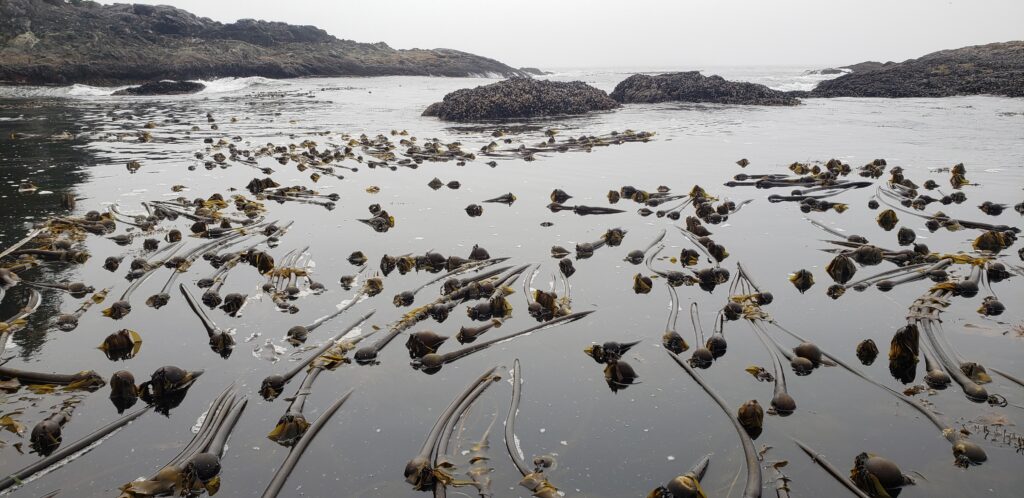
What are some key policy barriers to kelp and marine management?
Connie and Jasmin: Fisheries & Oceans is responsible for safeguarding our waters and managing Canada’s fisheries and oceans resources. Canada has the largest coastline in the world, and it’s a challenge to adequately manage these huge ocean areas through one department. As a result, regulation does not always reflect the latest state-of-knowledge or is implemented/updated rapidly enough to keep up with the rapid changes of our time. For example, there is a lack of regulation and permitting processes for urchin management beyond commercial harvests. Despite widespread urchin barrens and rapidly disappearing kelp forests, there is no process for urchin harvest, relocation, or removal (density control) for restoration.
Another challenge for kelp restoration and farming is sourcing reproductive tissue to grow kelp gametophytes in the lab. Currently, the province recommends kelp outplanted at a restoration site or farm to be sourced from a wild population <50 km away. In many regions, kelp is completely gone from stretches of coastline longer than 50 km, so there are no wild populations to source from. It is critical to preserve the genetic diversity and health of remaining wild kelp populations, so our hope is that recent kelp genetics research can help better inform regulation on this front.
“In five year’s time, we need to see q’am’ forests all through the coast growing anew—life-sustaining cathedrals making oxygen for us all, absorbing carbon dioxide, producing food, providing habitat. We need to ensure our oceans do not die—for the sake of us all.”
~ Connie Crocker
What do you see as some of the key policy recommendations?
Connie and Jasmin: The provincial government should work in partnership with Coastal First Nations to develop robust kelp reforestation policies and roadmaps that integrate Indigenous knowledge with western science. Further, departments such as Fisheries and Oceans, whom we work with can continue to address regulatory restrictions. This could include working with Indigenous nations to harvest sea urchin. Left unchecked by predators such as sunflower sea stars or sea otters, sea urchins can transform a kelp forest into an underwater barren. Harvesting sea urchins would help protect q’am’ forests and provide First Nation communities an opportunity to support traditional food and commercial harvesting.
Supporting programs such as Kelp Rescue is also important as they create awareness and educate the general public on the interlinked benefits of q’am’ forest restoration including mitigating climate change, restoring ocean health, and preserving habitats.
Finally, we both think more programs, incentives, and support for Indigenous youth stewardship and conservation of q’am’ forests (i.e. training for diving, planting kelp, integrating western science and Indigenous knowledge) is incredibly important!
“I remember when I was 6 or 7—you couldn’t see the bottom of the ocean in some parts as the kelp forests were so thick. With our traditional harvesting, traditional practices and knowledge we knew to keep everything in balance—to take only what you need. That changed, the seasons changed, and now the q’am’ forests are dying. The most important thing now is for Coastal First Nations to have stewardship and for the young people in Coastal First Nation communities to steward the kelp forest for the good of their own nation, the ocean, the climate, and future generations.”
~ Florence James
What are some final words you’d like to share on how and why we should restore q’am’ forests?
Connie, Florence, and Rocky:
We need kelp reforestation on a larger scale … in front of every First Nation on the coast.
The restoration of our ocean health is a dire and urgent situation and the public needs to know. We are stronger working together. A Canada wide awareness campaign is what is needed.
We need to ensure that kelp forests flourish and blue solutions are created to mitigate the impacts of climate change, support reconciliation, and provide a healthier future for generations to come.
Our ultimate goal is to empower Coastal First Nations to do the restoration work themselves and for Kelp Rescue Initiative to provide tools and a road map to support them to do this before it’s too late. We would like to see youth driving the stewardship of the kelp forests for the good of their own nation, the ocean, and future generations.
Conclusion
“Take only what you need,” was one of the important messages Florence and Connie imparted to us for the day, and wanted to share with others as overfishing by humans is one of the contributors to q’am’ forest decline. One message that stood out clearly was the role that colonization and difference across worldview has and continues to play in impacting the marine environment. Viewing the ocean through a more holistic lens would benefit the restoration of q’am’ forests and advance reconciliation efforts on the coast as the oceans hold storied memories and teachings of the people who have lived there since time immemorial.
A solution to climate change on the coast then, is quite simply to listen to the people who have had and continue to have an intimate knowledge and understanding of how and why ocean ecosystems thrive. Drawing on the wisdom of intergenerational knowledge restores the ocean with Indigenous narratives important to the survival for all.
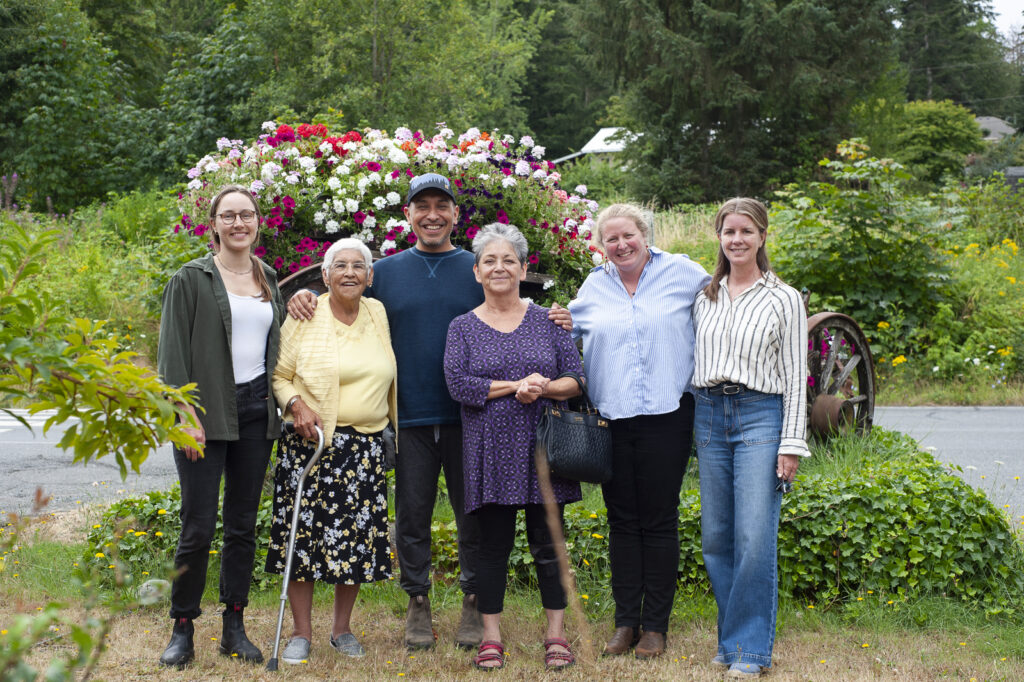
Communications and written support by
Maria Shallard is the Director, Indigenous Research at the Canadian Climate Institute and is of mixed Pune’luxutth’ and settler ancestry. Maria holds a Master’s in Geography from the University of Guelph with a specialization in political ecology and Indigenous ocean governance, an interdisciplinary Bachelor of Arts from the University of Victoria with a double major in environmental studies and Canadian environmental history, with a minor in Indigenous studies, and certificates in coaching, leadership, and communication. She has over a decade of professional experience as an educator, project manager, and researcher, coordinating Indigenous and western knowledge programs.
Janina Stajic is the Communication Manager at the Canadian Climate Institute and is of mixed Scottish/English settler ancestry. Janina has a Master’s degree in post-colonial studies from the University of London, England and a BA in English and History from the University of British Columbia. She has been working in communications and public engagement for approximately 20 years and in a variety of countries – England, Egypt, the United States, and Canada.
Jasmin Schuster is a kelp researcher and the program manager for the Kelp Rescue Initiative. She grew up in Austria, a land-locked country, but found her love for the ocean through diving. The first time Jasmin saw a kelp forest was on the east coast of Canada, in Newfoundland, where the stark contrast between widespread urchin barrens and remaining kelp beds prompted her to dedicate her PhD research on these ecosystems. She relocated to Vancouver Island in 2021, where she continued her research of kelp and urchin ecosystems and quickly fell in love with the magnificent canopy formers on this coast. Inspired to move from knowledge to action, Jasmin took a new position with the Kelp Rescue Initiative in 2023 to work on kelp restoration and research.


